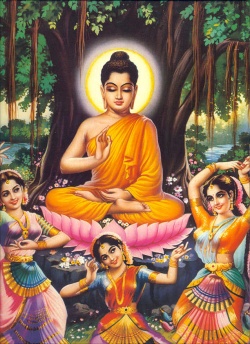Story of Mara
Mara in the Buddhist tradition is believed to be the personification of Death; the Evil Force; or the Tempter. He may be understood as Devil or Satan in popular terms.
Mara, when considered as one-fold he refers to the ‘defilements’ (kilesas) or death only. He is classified as five-fold by way of Khandha (Aggregate Mara), Kilesa (Defilement) Mara, Abhisankhara (Accumulated Karma) Mara, Macchu (Death) Mara, and Devaputta (four archangels of Yama). In the older texts he is believed to be the personification of five aggregates of the mind-body complex.
Mara is called ‘Namuchi’ as no one can escape him. He is called ‘Vasavatti’, because “he rules all”. Whenever, he finds some one treading the path of virtuosity, he creates obstacles and hindrances. For example, in the Shresthi-Jataka when a king thought of giving alms to a Paccheka Buddha, who had entered the palace: Mara put the obstacle of creating a very deep hell measuring many fathoms in width, with several dreadful sights accompanied with terrible sounds and tremulous flames.The legends of Mara have its origin in the Padhana Sutta. There, Mara is shown as visiting the Buddha on the bank of the river Neranjara to tempt and dissuade him from his Enlightenment. Mara’s army is ten-fold, namely, Lust; Discontent or Aversion; Hunger and Thirst; Craving; Sloth and Torpor; Cowardice; Doubt; Hypocrisy and Stupidy; Notion of Name and Fame and Honour and Glory; and Self-Conceit. His three daughters are Tanha (Craving), Arati (Discontent), and Raga (Lust).
